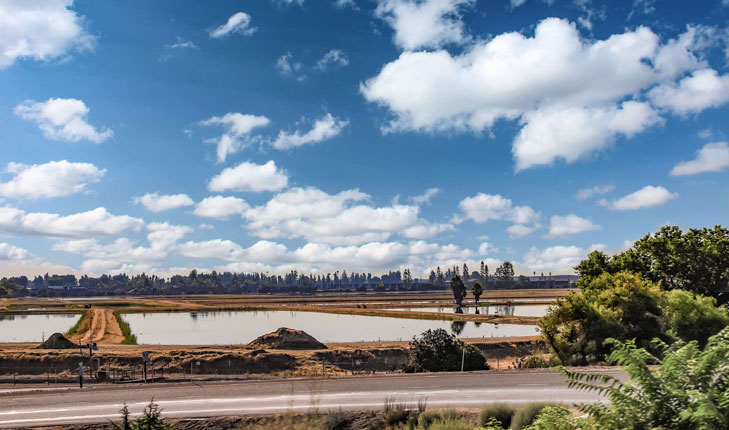The Public Policy Institute of California, in partnership with the California Water Institute at Fresno State, hosted an event on campus Sept. 20 to share the findings of its report, “Managing Water and Farmland Transitions in the San Joaquin Valley.”
According to the report, the success of the Sustainable Groundwater Management Act relies on accelerating farmland repurposing efforts. This includes alternative land uses like solar development, water-limited cropping, water-efficient new housing, habitat restoration and recharge basins.
The report also highlights the importance of investing in water infrastructure to expand recharge efforts.
Dedicated recharge basins could bring multiple benefits, like maximizing flood waters in wet years, raising groundwater levels beneath groundwater-dependent disadvantaged communities, and possibly improving water quality, according to Fresno State water experts.
California Governor Gavin Newsom issued Executive Order N-10-23 in August to reduce the risks of catastrophic flooding in the San Joaquin River and its tributaries, the Tule Lake Basin and its tributaries (including the Kings River, Tule River and Kern River) and on the Central Coast.
The order is intended to streamline the repair or replacement of levees and weirs and restore channel capacity and other flood-control infrastructure. The governor has issued several executive orders this year to address drought conditions and mitigate flooding after a series of winter storm events pummeled the state.
Laura Ramos, interim director of the California Water Institute’s Research and Education Division, said the repair and restoration of existing conveyance and flood control infrastructure is one of many steps the state needs to take to move forward with the report’s takeaway on recharge basins.
“In order to do more recharge, infrastructure repair and restoration is absolutely needed, but it’s not the only thing that’s needed,” Ramos said. “We need to do more because climate science is telling us that flooding is going to continue happening and it’s going to get worse, and drought will continue to happen and get worse.”
Ramos and Cordie Qualle, a lecturer in the Lyles College of Engineering at Fresno State, have advocated for groundwater recharge as one solution to reduce flood damage and prepare for drought. Ramos said groundwater recharge has typically been managed by a county, city or special district in the past, which may not allow officials to take advantage of future floods for recharge. Her suggested solution is to focus on managing recharge on a regional basis moving forward.
To create a long-term regional effort to capture flood water for recharge, Ramos said there needs to be a regional groundwater recharge management team to coordinate the mapping of floodwater sources and desirable groundwater recharge locations, and to coordinate the implementation of groundwater recharge facilities at those locations. She added that infrastructure is required to move the floodwater to the recharge facilities.
Dr. Thomas Holyoke, professor of political science at Fresno State, said the regional management team could also be responsible for obtaining rights to flood water and other excess water not otherwise claimed under the state’s water rights system, as well as for coordinating the discharge of the floodwater to the developed recharge facilities. He suggests the state’s Water Resources Control Board may want to refine its management of existing surface water rights to identify any additional unclaimed water the state can use for groundwater recharge.
“Diverting excess runoff to groundwater recharge sites throughout the region in a coordinated manner will diminish flood peaks, thereby reducing damage to communities and increasing groundwater levels, which will sustain domestic and agricultural uses during droughts,” Qualle said.
Another piece of the puzzle needs to be educating farmers, city managers, irrigation districts and water districts about how to take flood water for recharge, Ramos said, as well as educating residents on groundwater recharge. Residents in rural areas and disadvantaged communities dependent on domestic wells should be targeted, since they are usually the first affected by droughts and flooding, she said.
“There needs to be an effort to be truly regionwide and not in geographical silos,” she said.
(Story by Julissa Zavala, California Water Institute)





